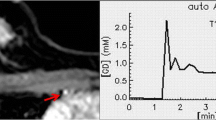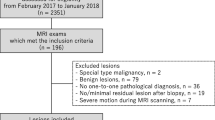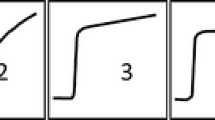Abstract
Magnetic resonance imaging (MRI) is particularly attractive for clinical application in perfusion imaging thanks to the absence of ionizing radiation and limited volumes of contrast agent (CA) necessary. Dynamic contrast-enhanced MRI (DCE–MRI) involves sequentially acquiring T1-weighted images through an organ of interest during the passage of a bolus administration of CA. It is a particularly flexible approach to perfusion imaging as the signal intensity time course allows not only rapid qualitative assessment, but also quantitative measures of intrinsic perfusion and permeability parameters. We examine aspects of the T1-weighted image series acquisition, CA administration, post-processing that constitute a DCE–MRI study in clinical practice, before considering some heuristics that may aid in interpreting the resulting contrast enhancement time series. While qualitative DCE–MRI has a well-established role in the diagnostic assessment of a range of tumours, and a central role in MR mammography, clinical use of quantitative DCE–MRI remains limited outside of clinical trials. The recent publication of proposals for standardized acquisition and analysis protocols for DCE–MRI by the Quantitative Imaging Biomarker Alliance may be an opportunity to consolidate and advance clinical practice.







Similar content being viewed by others
References
Hanahan D, Weinberg R (2000) The hallmarks of cancer. Cell 144(5):646–674. https://doi.org/10.1016/S0092-8674(00)81683-9
Radue EW, Kendall BE (1978) Xenon enhancement in tumours and infarcts. Neuroradiology 16:224–227
Cherry SR, Carnochan P, Babich JW, Serafini F, Rowell NP, Watson IA (1990) Quantitative in vivo measurements of tumor perfusion using rubidium-81 and positron emission tomography. J Nucl Med 31(8):1307–1315
Brix G, Semmler W, Port R, Schad LR, Layer G, Lorenz WJ (1991) Pharmacokinetic parameters in CNS Gd-DTPA enhanced MR imaging. J Comput Assist Tomogr 15(4):621–628
Petralia G, Preda L, D’Andrea G, Viotti S, Bonello L, De Filippi R, Bellomi M (2010) CT perfusion in solid-body tumours. Part I: technical issues. Radiol Med 115(6):843–857. https://doi.org/10.1007/s11547-010-0519-y
Petralia G, Bonello L, Viotti S, Preda L, d’Andrea G, Bellomi M (2010) CT perfusion in oncology: how to do it. Cancer Imaging 10:8–19. https://doi.org/10.1102/1470-7330.2010.0001
Thomas DL, Lythgoe MF, Pell GS, Calamante F, Ordidge RJ (2000) The measurement of diffusion and perfusion in biological systems using magnetic resonance imaging. Phys Med Biol 45(8):R97–R138. https://doi.org/10.1088/0031-9155/45/8/201
Villringer A, Rosen BR, Belliveau JW (1988) Dynamic imaging with lanthanide chelates in normal brain: contrast due to magnetic susceptibility effects. Magn Reson Med 6:164–174
Detre JA, Leigh JS, Williams DS, Koretsky AP (1992) Perfusion imaging. Magn Reson Med 2:337–345
Krestin GP, Steinbrich W, Friedmann G (1989) Adrenal masses: evaluation with fast gradient-echo MR imaging and Gd-DTPA-enhanced dynamic studies. Radiology 171(3):675–680
Zierler K (2000) Indicator dilution methods for measuring blood flow, volume, and other properties of biological systems: a brief history and memoir. Ann Biomed Eng 28(8):836–848
Milnor WR (1990) Cardiovascular physiology. Oxford University Press, New York
McDonald DM, Baluk P (2005) Imaging of angiogenesis in inflamed airways and tumors: newly formed blood vessels are not alike and may be wildly abnormal: Parker B. Francis Lecture. Chest 128(6 Suppl):602S–608S
Xiao Y, Paudel R, Liu J, Ma C, Zhang Z, Zhou S (2016) MRI contrast agents: classification and application (Review). Int J Mol Med 38:1319–1326. https://doi.org/10.3892/ijmm.2016.2744
Tofts PS (1997) Modeling tracer kinetics in dynamic Gd-DTPA MR imaging. J Magn Reson Imaging 7(1):91–101. https://doi.org/10.1002/jmri.1880070113
Sourbron SP, Buckley DL (2013) Classic models for dynamic contrast-enhanced MRI. NMR Biomed 26(8):1004–1027. https://doi.org/10.1002/nbm.2940
Khalifa F, Soliman A, El-Baz A et al (2014) Models and methods for analyzing DCE–MRI: a review. Med Phys 41(12):124301. https://doi.org/10.1118/1.4898202
Tofts PS, Brix G, Buckley DL et al (1999) Estimating kinetic parameters from dynamic contrast-enhanced T(1)-weighted MRI of a diffusable tracer: standardized quantities and symbols. J Magn Reson Imaging 10:223–232
Buckley DL, Kerslake RW, Blackband SJ, Horsman A (1994) Quantitative analysis of multi-slice Gd-DTPA enhanced dynamic MR images using an automated simplex minimization procedure. Magn Reson Med 1994 32(5):646–651. Erratum in: Magn Reson Med 33(2):282
Terada T, Nambu K, Hyotani G et al (1992) A method for quantitative measurement of cerebral vascular-permeability using X-ray CT and iodinated contrast-medium. Neuroradiology 34:290–296
Taylor J, Summers PE, Keevil SF, Saks AM, Diskin J, Hilton PJ, Ayers AB (1997) Magnetic resonance renography: optimisation of pulse sequence parameters and Gd-DTPA dose, and comparison with radionuclide renography. Magn Reson Imaging 15(6):637–649
US Food & Drug Administration (2017) Safety: Gadolinium-based Contrast Agents (GBCAs): Drug Safety Communication—Retained in Body; New Class Warnings. https://www.fda.gov/Safety/MedWatch/SafetyInformation/SafetyAlertsforHumanMedicalProducts/ucm589580.htm. Accessed 4 Sept 2019
Cuenod CA, Balvay D (2013) Perfusion and vascular permeability: basic concepts and measurement in DCE-CT and DCE–MRI. Diagn Interv Imaging 94(12):1187–1204. https://doi.org/10.1016/j.diii.2013.10.010
Tofts PS, Parker GJM (2013) DCE–MRI: acquisition and analysis techniques. In: Barker PB, Golay X, Zaharchuk G (eds) Clinical perfusion MR. Cambridge University Press, Cambridge, pp 58–74
Shukla-Dave A, Obuchowski NA, Chenevert TL et al (2019) Quantitative imaging biomarkers alliance (QIBA) recommendations for improved precision of DWI and DCE–MRI derived biomarkers in multicenter oncology trials. J Magn Reson Imaging 49(7):e101–e121. https://doi.org/10.1002/jmri.26518
Thrippleton MJ, Backes WH, Sourbron S et al (2019) Quantifying blood-brain barrier leakage in small vessel disease: review and consensus recommendations. Alzheimers Dement 15(6):840–858. https://doi.org/10.1016/j.jalz.2019.01.013
Mann RM, Kuhl CK, Kinkel K, Boetes C (2008) Breast MRI: guidelines from the European Society of Breast Imaging. Eur Radiol 18(7):1307–1318. https://doi.org/10.1007/s00330-008-0863-7
PI-RADS™ Prostate Imaging – Reporting and Data System 2015 version 2. https://www.acr.org/-/media/ACR/Files/Pi-RADS/PIRADS-V2. Accessed 1 Oct. 2019
Haase A, Frahm J, Matthaei D, Hanicke W, Merboldt KD (1986) FLASH imaging—rapid NMR imaging using low flip-angle pulses. J Magn Reson 67:258–266
Brookes JA, Redpath TW, Gilbert FJ, Murray AD, Staff RT (1999) Accuracy of T1 measurement in dynamic contrast-enhanced breast MRI using two- and three-dimensional variable flip angle fast low-angle shot. J Magn Reson Imaging 9(2):163–171
Buckley L, Parker GJM (2005) Measuring contrast agent concentration in T1-weighted dynamic contrast-enhanced MRI. In: Jackson A, Buckley DL, Parker GJM (eds) Dynamic contrast-enhanced magnetic resonance imaging in oncology. Medical radiology (diagnostic imaging). Springer, Berlin, pp 69–79. https://doi.org/10.1007/3-540-26420-5_5
Gaddikeri S, Gaddikeri RS, Tailor T, Anzai Y (2016) Dynamic contrast-enhanced MR imaging in head and neck cancer: techniques and clinical applications. AJNR Am J Neuroradiol 37(4):588–595
Davis AJ, Remain R, Srinivasan A, Fatterpekar GM (2018) Perfusion and permeability imaging for head and neck cancer: theory, acquisition, postprocessing, and relevance to clinical imaging. Magn Reson Imaging Clin N Am 26(1):19–35. https://doi.org/10.1016/j.mric.2017.08.002
Bane O, Hectors SJ, Wagner M et al (2018) Accuracy, repeatability, and interplatform reproducibility of T1 quantification methods used for DCE–MRI: results from a multicenter phantom study. Magn Reson Med 79(5):2564–2575. https://doi.org/10.1002/mrm.26903
Fram EK, Herfkens RJ, Johnson GA et al (1987) Rapid calculation of T1 using variable flip angle gradient refocused imaging. Magn Reson Imaging 5:201–220
Wang HZ, Riederer SJ, Lee JN (1987) Optimizing the precision in T1 relaxation estimation using limited flip angles. Magn Reson Med 5:399–416
Di Giovanni P, Azlan CA, Ahearn TS, Semple SI, Gilbert FJ, Redpath TW (2010) The accuracy of pharmacokinetic parameter measurement in DCE–MRI of the breast at 3T. Phys Med Biol 55(1):121–132
Treier R, Steingoetter A, Fried M, Schwizer W, Boesiger P (2007) Optimized and combined T1 and B1 mapping technique for fast and accurate T1 quantification in contrast-enhanced abdominal MRI. Magn Reson Med 57(3):568–576
Koh TS, Bisdas S, Koh DM, Thng CH (2011) Fundamentals of tracer kinetics for dynamic contrast-enhanced MRI. J Magn Reson Imaging 34:1262–1276. https://doi.org/10.1002/jmri.22795
Leach MO, Brindle KM, Evelhoch JL et al (2005) The assessment of antiangiogenic and antivascular therapies in early-stage clinical trials using magnetic resonance imaging: issues and recommendations. Br J Cancer 92(9):1599–1610. https://doi.org/10.1038/sj.bjc.6602550
Radjenovic A, Ridgway JP, Smith MA (2006) A method for pharmacokinetic modelling of dynamic contrast enhanced MRI studies of rapidly enhancing lesions acquired in a clinical setting. Phys Med Biol 51(9):N187–N197. https://doi.org/10.1088/0031-9155/51/9/N03
Essig M, Shiroishi MS, Nguyen TB et al (2013) Perfusion MRI: the five most frequently asked technical questions. AJR Am J Roentgenol 200(1):24–34. https://doi.org/10.2214/AJR.12.9543
Brookes JA, Redpath TW, Gilbert FJ, Murray AD, Staff RT (1999) Accuracy of T1 measurement in dynamic contrast-enhanced breast MRI using two- and three-dimensional variable flip angle fast low-angle shot. J Magn Reson Imaging 9:163–171
Jansen MJA, Kuijf HJ, Veldhuis WB, Wessels FJ, van Leeuwen MS, Pluim JPW (2017) Evaluation of motion correction for clinical dynamic contrast enhanced MRI of the liver. Phys Med Biol 62(19):7556–7568. https://doi.org/10.1088/1361-6560/aa8848
Flanagan FL, Murray JG, Gilligan P, Stack JP, Ennis JT (1995) Digital subtraction in Gd-DTPA enhanced imaging of the breast. Clin Radiol 50:848–854
Schnall MD, Blume J, Bluemke DA et al (2006) Diagnostic architectural and dynamic features at breast MR imaging: multicenter study. Radiology 238:42–53
Macura KJ, Ouwerkerk R, Jacobs MA, Bluemke DA (2006) Patterns of enhancement on breast MR images: interpretation and imaging pitfalls. Radiographics 26:1719–1734. https://doi.org/10.1148/rg.266065025
Tuncbilek N, Karakas HM, Okten OO (2005) Dynamic contrast enhanced MRI in the differential diagnosis of soft tissue tumors. Eur J Radiol 53(3):500–505. https://doi.org/10.1016/j.ejrad.2004.04.012
Reddick WE, Taylor JS, Fletcher BD (1999) Dynamic MR imaging (DEMRI) of microcirculation in bone sarcoma. J Magn Reson Imaging 10(3):277–285. https://doi.org/10.1002/(sici)1522-2586(199909)10:3%3c277:aid-jmri8%3e3.0.co;2-s
Ostergaard M, Stoltenberg M, Løvgreen-Nielsen P, Volck B, Sonne-Holm S, Lorenzen I (1998) Quantification of synovistis by MRI: correlation between dynamic and static gadolinium-enhanced magnetic resonance imaging and microscopic and macroscopic signs of synovial inflammation. Magn Reson Imaging 16(7):743–754. https://doi.org/10.1016/s0730-725x(98)00008-3
Medved M, Karczmar G, Yang C et al (2004) Semiquantitative analysis of dynamic contrast enhanced MRI in cancer patients: variability and changes in tumor tissue over time. J Magn Reson Imaging 20(1):122–128. https://doi.org/10.1002/jmri.20061
Krishnan P, Murphy A, Aviv RI (2017) CT-based techniques for brain perfusion. Top Magn Reson Imaging 26(3):113–119. https://doi.org/10.1097/RMR.0000000000000129
Gückel F, Brix G, Rempp K, Deimling M, Röther J, Georgi M (1994) Assessment of cerebral blood volume with dynamic susceptibility contrast enhanced gradient-echo imaging. J Comput Assist Tomogr 18(3):344–351
Mlynash M, Eyngorn I, Bammer R, Moseley M, Tong DC (2005) Automated method for generating the arterial input function on perfusion-weighted MR imaging: validation in patients with stroke. AJNR Am J Neuroradiol 26(6):1479–1486
Li X, Cai Y, Moloney B et al (2016) Relative sensitivities of DCE–MRI pharmacokinetic parameters to arterial input function (AIF) scaling. J Magn Reson 269:104–112. https://doi.org/10.1016/j.jmr.2016.05.018
Chouhan M, Bainbridge A, Atkinson D et al (2016) Estimation of contrast agent bolus arrival delays for improved reproducibility of liver DCE MRI. Phys Med Biol 61(19):6905–6918. https://doi.org/10.1088/0031-9155/61/19/6905
Parker GJ, Roberts C, Macdonald A et al (2006) Experimentally-derived functional form for a population-averaged high-temporal-resolution arterial input function for dynamic contrast-enhanced MRI. Magn Reson Med 56(5):993–1000. https://doi.org/10.1002/mrm.21066
Rata M, Collins DJ, Darcy J et al (2016) Assessment of repeatability and treatment response in early phase clinical trials using DCE–MRI: comparison of parametric analysis using MR- and CT-derived arterial input functions. Eur Radiol 26(7):1991–1998. https://doi.org/10.1007/s00330-015-4012-9
Ziayee F, Müller-Lutz A, Gross J (2018) Influence of arterial input function (AIF) on quantitative prostate dynamic contrast-enhanced (DCE) MRI and zonal prostate anatomy. Magn Reson Imaging 53:28–33. https://doi.org/10.1016/j.mri.2018.06.004
Ioannidis GS, Maris TG, Nikiforaki K, Karantanas A, Marias K (2019) Investigating the correlation of Ktrans with semi-quantitative MRI parameters towards more robust and reproducible perfusion imaging biomarkers in three cancer types. IEEE J Biomed Health Inf 23(5):1855–1862. https://doi.org/10.1109/JBHI.2018.2888979
Author information
Authors and Affiliations
Contributions
Drs. SC and GP proposed the topic of this review. Drs. PES and GP performed the literature search and initial draft. All authors contributed to the critical revision of the work and approved the final manuscript.
Corresponding author
Ethics declarations
Conflict of Interest
The authors declare that they have no conflict of interest.
Research involving human participants and/or animals
This article does not contain any studies with human participants or animals performed by any of the authors.
Informed consent
The manuscript does not contain clinical studies or patient data requiring ethical committee approval.
Additional information
Publisher's Note
Springer Nature remains neutral with regard to jurisdictional claims in published maps and institutional affiliations.
Rights and permissions
About this article
Cite this article
Petralia, G., Summers, P.E., Agostini, A. et al. Dynamic contrast-enhanced MRI in oncology: how we do it. Radiol med 125, 1288–1300 (2020). https://doi.org/10.1007/s11547-020-01220-z
Received:
Accepted:
Published:
Issue Date:
DOI: https://doi.org/10.1007/s11547-020-01220-z




